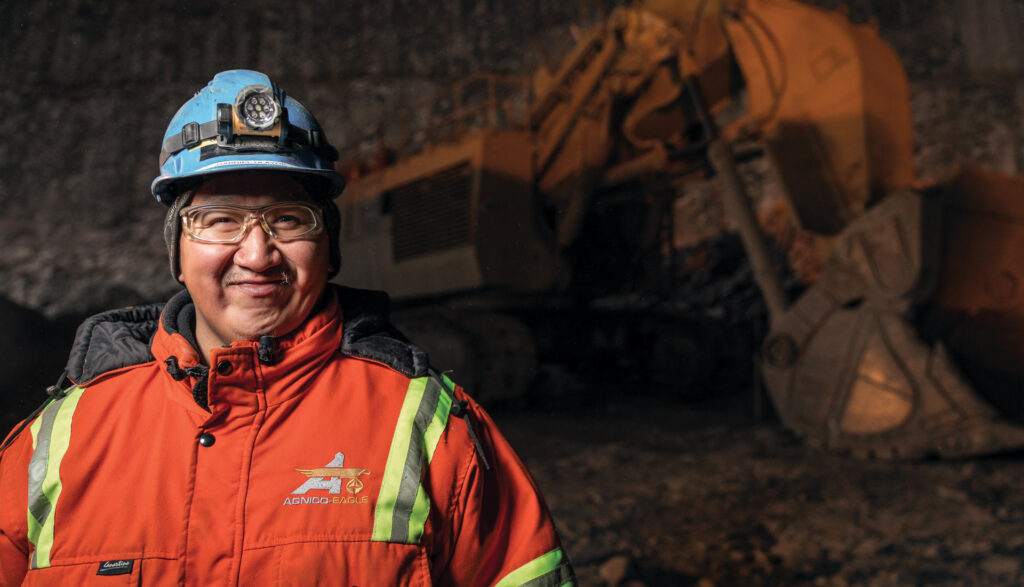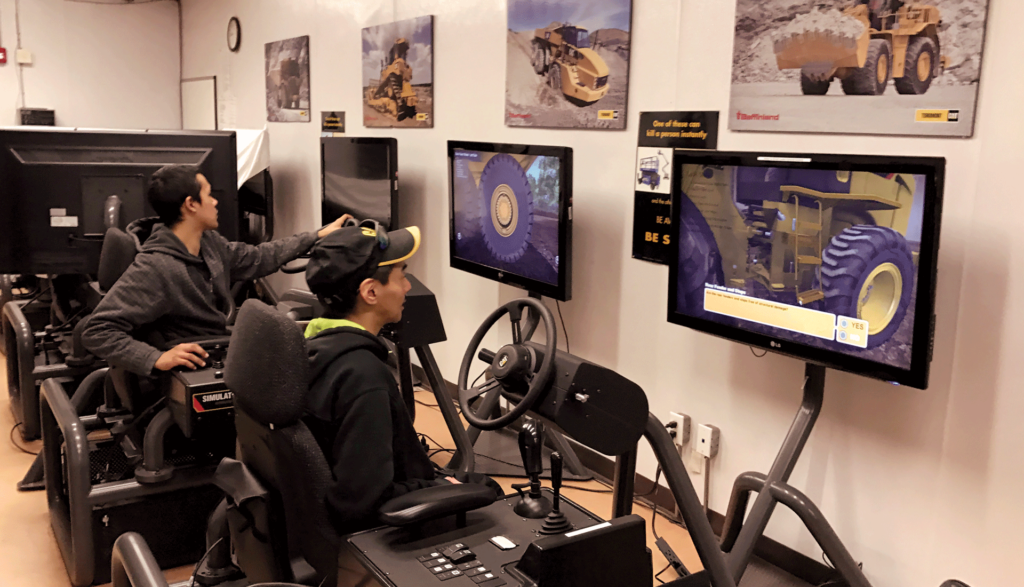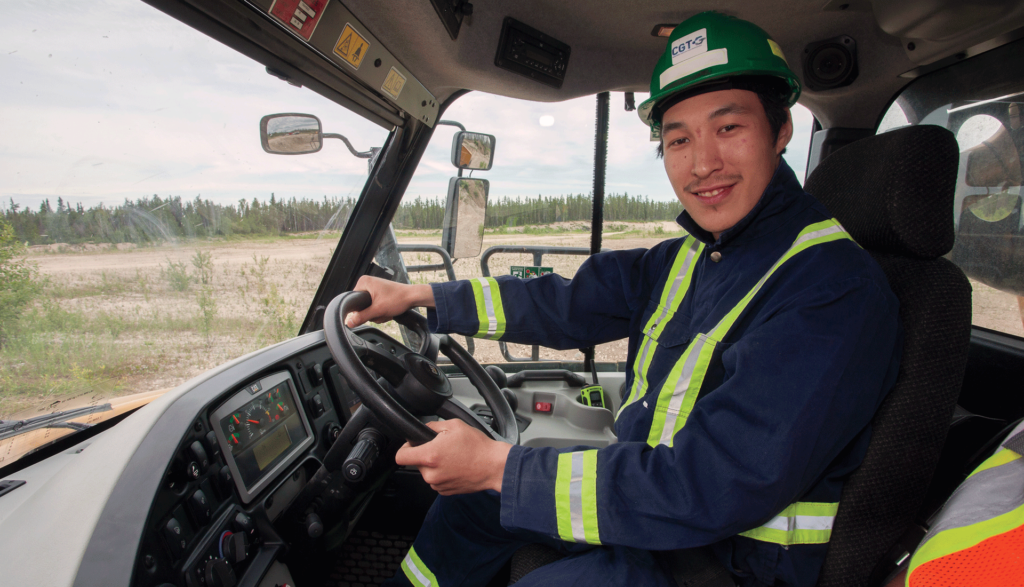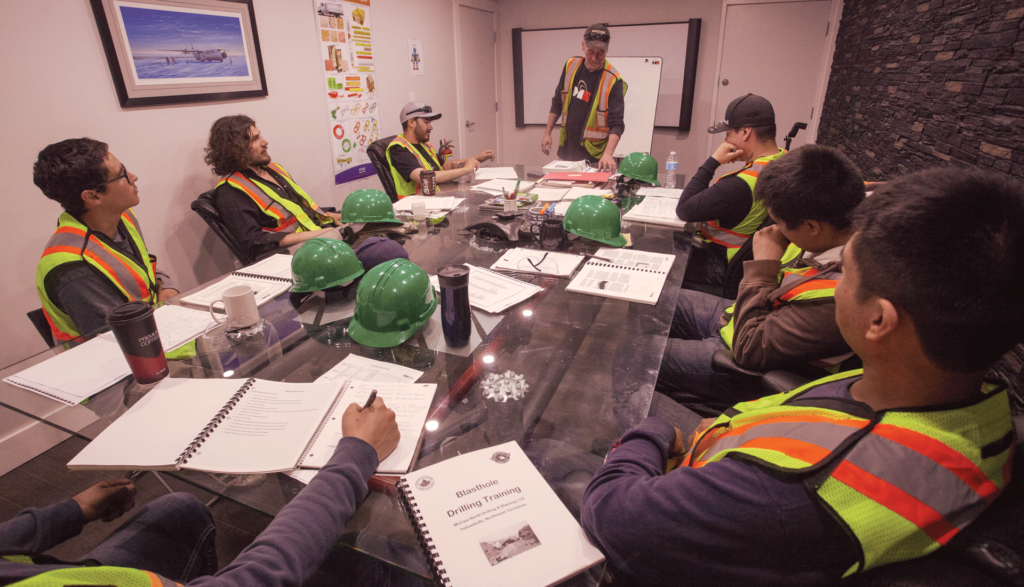
Learning Curves
Mine training varies across the North but it’s all about collaboration and cooperation
By Graham Chandler
Hilary Jones has seen a lot of trends and positive developments in mine training in the North over the past decade. Due to retire at year’s end, the General Manager of the Yellowknife-based Mine Training Society (MTS) offers the main reason for its success.
“Our Board of Directors are the real heroes,” she says. “We wouldn’t exist if we didn’t have such a great Board.” As the MTS is a partnership between Aboriginal governments, public government and the mining industry, all of those organizations play a role. “We have four Indigenous groups, government, three large diamond mines, and the Department of Education,” she says. It’s this kind of cooperation that is the hallmark of mine training throughout the North.
Northwest Territories
In NWT, the primary partnership for meeting mine training needs is one between the MTS, Aurora College, and the mining industry. “It’s pretty well all done in partnership; we work very closely with three areas, like a triangle,” explains Mike MacPherson, program head of mining and industry training at Aurora College in Yellowknife. “The Mine Training Society gets the funding, we run a large number of the programs, and the mines hire the graduates.” Aurora College opened the Centre for Mine and Industry Training in Fort Smith early this year and offers a number of programs including Introduction to the Mining Industry, Introduction to Underground Mining, and the Underground Miner Training programs. As well, it offers a Heavy Equipment Operator program that trains students on the operation of heavy equipment pertinent to the mining industry. Aurora College also provides a Leadership Development program aimed at mine workers.
Nunavut
In Nunavut, training generally follows similar patterns and topics, but currently more of it is undertaken by the
mines themselves. In the Kivalliq region for example, Agnico Eagle Mines has a labour pool process during which applicants participate in pre-employment training such as a week-long work readiness training and a site readiness training. Following those, applicants are eligible to multiple entry level opportunities. Agnico Eagle Mines also has on-site trainee programs for Haul Truck, Process Plant and underground operator. “Every month we start new intakes of trainees that we develop internally – most trainees are starting the programs with limited experience on equipment. We are providing their first experience in mining.” says Patrick Roy, Regional Superintendent for Community Relations and Training.
In August this year, Agnico Eagle launched a new Underground Trainee Program at its Meliadine mine, helping Inuit from Kivalliq communities take their first step into a career in mining. Its stated goal is to have these potential employees ready to work after 28 days of training. They can then enter the Underground Mining Career Path, which the company also developed, leading them to more challenging opportunities. Four Inuit trainees from Chesterfield Inlet, Coral Harbour and Rankin Inlet, have already completed the training and have secure permanent employment.
“Interested employees also have the opportunity to become skilled workers via multiple apprenticeship programs offered on our sites such as Heavy Duty Mechanic, Millwright, Electrician, etc. So far, four employees have obtained their Certification of Qualification (COQ) with us and two of them have even been promoted as trade supervisor,” says Roy.
In the Qikiqtani region, Baffinland Iron Mines Corporation currently handles most of its own training, too. “To the greatest extent we do the training ourselves,” says Grant Goddard, EVP Sustainable Development and Human Resources. “We focus on two streams. One is a five-day program called Work Readiness, put on in the communities, to make sure all our employees have the competence they need to be safe and effective operating at the site.” For grads, that’s followed by Job Shadowing at their Mary River site. It covers items like what fly-in fly-out is like, shift schedules, and what the individual jobs are like. “We also do heavy equipment operator training,” says Goddard. “With a company in Morrisburg, Ont. It’s both classroom and simulator, running loaders, small trucks giving them an introduction.” Baffinland’s apprenticeship program is currently dispersed, with Alberta and New Brunswick links.
“We are working with Nunavut Arctic College to get the apprenticeship program more Nunavut-based,” says Goddard. In addition, he says Baffinland has committed $10 million to build a new training centre in Pond Inlet. “The Qikiqtani Inuit Association are part of it, and we’re talking to the GN and Nunavut Arctic College who have a small design team.” In May the company started a leadership development program for high-potential Inuit employees. “Inuit cultural engagement is an important part of our training programs,” says Goddard. “We’ve tried to bring Inuit societal values into it.” This has included weekly storytelling sessions. “Our mainstream is really focused on training Inuit; to make them successful.”
Broadening the Picture
Goddard reckons people too often think mining is all about running big trucks, when there are so many other roles. So Baffinland initiated a one-year Inuit internship program, to show them other opportunities in the industry. “Both at our Oakville office as well as at site,” says Goddard. “We rotate them through different departments like finance, IT, procurement, HR, shipping, marketing groups.”
As NWT’s Aurora College moves toward becoming a polytechnic university, it too is broadening its training scope – potentially to include new mining-related programs like leadership and innovation, business administration, accounting, HR, or technology programs related to the mining industry. Or industry-driven applied research. “A polytechnic university affords industry the opportunity to engage in applied research of relevance to the mining industry,” says Tom Weegar, President of Aurora College. “This applied research – in partnership with a program at the polytechnic university – would be undertaken to address an identified need the mining industry currently faces, either with respect to production, innovation, and/or efficiencies.” Which will further grow the opportunities for cooperation in mine training by providing a wider variety of highly-qualified individuals to work in the industry. “This is of huge importance to most mining operations,” says Weegar. MN
“Inuit cultural engagement is an important part of our training programs”

The mining industry introduction course is generally run in the small communities says MacPherson. “Last year we ran it in Lutsel K’e, Fort Providence, Fort Simpson and Fort Smith. It’s an opportunity for students to feel out the mining industry and see if it’s a career they’d like.” It’s also a prerequisite for the surface and underground miner programs.
Special offerings have included a five-week geoscience field assistant program. As exploration activity is up and down, “we run it when industry requires it,” says MacPherson.
Jones says facilities are excellent. “We have simulators, great instructors, and we have a working pit where people can actually use underground and surface equipment hands-on,” she says.
“And when they come out of the program they’ve already got their safety ticket.”
Integral to planning course offerings is anticipating industry’s requirements and this is where MTS’ Board makeup is helpful. “They are talking to us and letting us know what they need,” says MacPherson. Training plans react to expected highdemand areas. For example, there’s a current need for surface miners with the new Gahcho Kué Mine. But the Prairie Creek Mine, expected to become operational in 2021, will be underground. There are other inputs, too, like projections from MTS’ mining partners and the Conference Board of Canada. “So we have a pretty good handle on what is necessary,” says Jones. In balancing demand and supply, cooperative efforts in NWT are a win-win: graduates are essentially guaranteed a job and the mines get the right personnel at the right time.

Nunavut
In Nunavut, training generally follows similar patterns and topics, but currently more of it is undertaken by the
mines themselves. In the Kivalliq region for example, Agnico Eagle Mines has a labour pool process during which applicants participate in pre-employment training such as a week-long work readiness training and a site readiness training. Following those, applicants are eligible to multiple entry level opportunities. Agnico Eagle Mines also has on-site trainee programs for Haul Truck, Process Plant and underground operator. “Every month we start new intakes of trainees that we develop internally – most trainees are starting the programs with limited experience on equipment. We are providing their first experience in mining.” says Patrick Roy, Regional Superintendent for Community Relations and Training.
In August this year, Agnico Eagle launched a new Underground Trainee Program at its Meliadine mine, helping Inuit from Kivalliq communities take their first step into a career in mining. Its stated goal is to have these potential employees ready to work after 28 days of training. They can then enter the Underground Mining Career Path, which the company also developed, leading them to more challenging opportunities. Four Inuit trainees from Chesterfield Inlet, Coral Harbour and Rankin Inlet, have already completed the training and have secure permanent employment. “Interested employees also have the opportunity to become skilled workers via multiple apprenticeship programs offered on our sites such as Heavy Duty Mechanic, Millwright, Electrician, etc. So far, four employees have obtained their Certification of Qualification
(COQ) with us and two of them have even been promoted as trade supervisor,” says Roy.
In the Qikiqtani region, Baffinland Iron Mines Corporation currently handles most of its own training, too. “To the greatest extent we do the training ourselves,” says Grant Goddard, EVP Sustainable Development and Human Resources. “We focus on two streams. One is a five-day program called Work Readiness, put on in the communities, to make sure all our employees have the competence they need to be safe and effective operating at the site.” For grads, that’s followed by Job Shadowing at their Mary River site. It covers items like what fly-in fly-out is like, shift schedules, and what the individual jobs are like. “We also do heavy equipment operator training,” says Goddard. “With a company in Morrisburg, Ont. It’s both classroom and simulator, running loaders, small trucks giving them an introduction.” Baffinland’s apprenticeship program is currently dispersed, with Alberta and New Brunswick links.
“We are working with Nunavut Arctic College to get the apprenticeship program more Nunavut-based,” says Goddard. In addition, he says Baffinland has committed $10 million to build a new training centre in Pond Inlet. “The Qikiqtani Inuit Association are part of it, and we’re talking to the GN and Nunavut Arctic College who have a small design team.” In May the company started a leadership development program for high-potential Inuit employees. “Inuit cultural engagement is an important part of our training programs,” says Goddard. “We’ve tried to bring Inuit societal values into it.” This has included weekly storytelling sessions. “Our mainstream is really focused on training Inuit; to make them successful.”

Broadening the Picture
Goddard reckons people too often think mining is all about running big trucks, when there are so many other roles. So Baffinland initiated a one-year Inuit internship program, to show them other opportunities in the industry. “Both at our Oakville office as well as at site,” says Goddard. “We rotate them through different departments like finance, IT, procurement, HR, shipping, marketing groups.”
As NWT’s Aurora College moves toward becoming a polytechnic university, it too is broadening its training scope – potentially to include new mining-related programs like leadership and
innovation, business administration, accounting, HR, or technology programs related to the mining industry. Or industry-driven applied research. “A polytechnic university affords industry the opportunity to engage in applied research of relevance to the mining industry,” says Tom Weegar, President of Aurora College.
“This applied research – in partnership with a program at the polytechnic university – would be undertaken to address an identified need the mining industry currently faces, either with respect to production, innovation, and/or efficiencies.” Which will further grow the opportunities for cooperation in mine training by providing a wider variety of highly-qualified individuals to work in the industry. “This is of huge importance to most mining operations,” says Weegar. MN

